Continuing the last blog, I want to now discuss the “legend” of the Lance McCollum-Michael Hedges harp guitar. In doing so, I hope at the same time to create an archive of Lance’s brief harp guitar output. I’m hopeful that this blog will eventually bring the rest of the information and new photos out of the woodwork – I’ve had good luck so far.
It hit me while tracking down these instruments and owners that we all, and especially I (whose “job” it is) are letting too many simple “record-keeping” opportunities slip through our fingers. Think about it – we struggle to do historical forensic work on Knutsens and Dyers (and hundreds of other forgotten makers) – how in the world is it that we’re not doing it with our modern builders when the information is right in front of us?!?! These instruments and their makers (and players) are going to be the equivalent of Knutsen, Dyer, and endless other “forgotten makers” a hundred years from now…and Harpguitars.net will still be up, preserving these legacies. And yet we find ourselves in the untenable position of having recently lost Lance, with his harp guitars (let alone the rest of his prolific output) undocumented. What’s wrong with this picture?
I can’t do it alone, so I remind harp guitar builders and owners to please continue to share these projects with us. (For example, I still have no idea how many harp guitars Ron Spillers built, and while I know how many Merrill has built, or most from my friend Duane Noble, I haven’t seen them all, nor know who they all went to.)
As for the late Lance McCollum, I count just five harp guitars so far, though there might be more. I’m not positive about the order, but for now will refer to them as HG1, HG2, etc.
As Lance began building these several years before I started Harpguitars.net and long before I started paying attention to modern instruments, I naturally “came late to the party.” Since HG.net began, I’ve seen photos of a couple of his over the years, but sadly hadn’t paid them much attention beyond adding a representative to the Galleries and Lance’s entry on the Luthier page.
And now, four years after his unexpected passing, I pick up where I left off. For me, the McCollum timeline investigation begins with his “infamous” post on an old Google Group guitar forum. This is still up (here), but I’ll paste it again below, so we don’t lose the record. A second archival post by Lance here concerns some of his thoughts on improvements to the Dyer harp guitar (I’m sure Dyer players will get a kick out of it). Though I only met him once, I can see how Lance might have gotten a reputation for being…how shall I put it?…well, not exactly burdened with humility. The bottom line is, I have no reason to doubt the gist of his story, which appeared in October 2000 in response to someone mentioning him as building harp guitars:
“Thanks, Wade. I guess the major amount of money I spent advertising in Acoustic Guitar with pictures of my harp guitar hasn’t caught many people’s eye 😉 So let me set the record straight: I BUILD HARP GUITARS. I build really good ones 🙂
“And I’m going to toot my own horn shamelessly here…If Michael Hedges were still alive, he would be playing one of my harp guitars. This was the plan…but unfortunately, it died with him. I received the ultimate compliment from him after meeting him at a show where I had brought my first harp guitar, which at a previous show I had told him was in production, and he asked to see it when it was completed. At that time Michael was getting approached by luthiers at every other show wanting to demo their guitars, so I was flattered that I would be meeting with him again. I arrived before the show at soundcheck, waited until he was free, and met Michael . . . I handed Michael the guitar and it was in standard tuning. And Michael strummed it once, smiled, and asked me if he could change the tunings. I, of course, said ‘Have at it! – I’ve been wanting to find out what it could do.’ In the following 15 minutes, I was treated to the most outrageous private medley from Michael’s harp guitar song list. He must have gone through about 15 tunings and after every one, his jaw was literally dropped. And the comments were just as overwhelming. (Can you guess I was just about wetting my pants in delight???) He inquired as to the price and said he had to go off to soundcheck, but asked me not to leave. (Like I would want to leave!!!) We talked at intermission and then met again after the show. This is where I got the ultimate in compliments. I asked him if he was interested in buying the harp guitar and his response was: ‘I would love to buy this guitar right now, at full price, (I’d offered him a discount) but the guitar is so inspirational, that if I were to buy it now (at the beginning of his touring) I’d want to stop doing everything else and write harp guitar pieces. So if it is still available when I get off tour, I will buy it. If not, we’ll build another one together.’ What more could I say . . . Unfortunately, Michael died on his way home from his tour. Not more than about 50 miles from his house. Even writing about this makes me sad.
“I’m occasionally brought back to that pleasant meeting because while he was on tour, he had recommended my name to at least two people regarding harp guitars and both have since become owners. One of them, Steve Rundell, who you will be hearing about soon, even named his guitar “Michael” in honor of his favorite player. I have a picture of Michael playing my first harp guitar; it’s a reminder of a very special evening. It’s on my website if anyone wants to see it.
“Michael was and continues to be my favorite fingerstyle guitarist. No, I don’t try to play his songs, but I feel his influences in my playing, as I’m sure many of us do.
“Thanks for letting me ramble. Oh, and by the way, Michael owned two Dyer harp guitars and one Gibson harp guitar, and a Klein electric harp guitar (he helped design the Klein). I had the pleasure of owning one of the really old Gibson harp guitars that turned out to be historically very significant (but that’s another story for another day – you know – about the one that got away). – Lance McCollum, McCollum Guitars, Oct 2, 2000”
Fascinating story isn’t it?! So a McCollum might have very well become Hedges’ first new professional harp guitar. The exchange certainly sounds plausible, and I’ll add some corroboration (and confusion) below. Frankly, with Hedges’ professional requirements, I’m surprised he was able to use the Dyer (and the black Knutsen) as long as he did.
And so our McCollum Harp Guitar Timeline “working model” can begin:
At long last, here is his HG#1! It is serialized #47, as Lance must have serialized his output consecutively, regardless of instrument type.
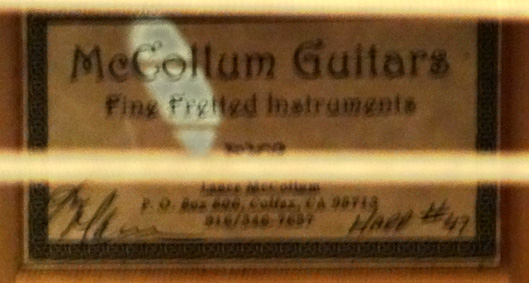
It has had one owner, David Borbas, who bought it on the last day of the 1997 Healdsburg Guitar Festival (“our wives set the price”) “after Michael Hedges did his thing.”
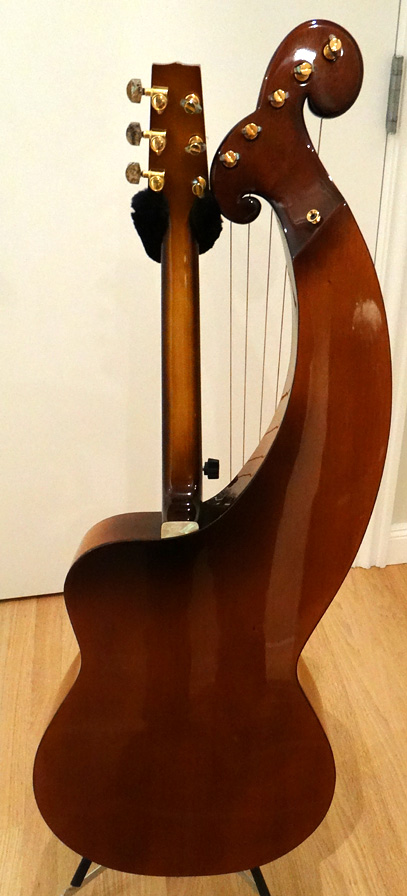
It’s ~15-3/4” wide and just over 4-3/4” deep with spruce top, mahogany back & sides, and thick vine inlay on the fretboard. He seems to have started with the Dyer form; note the Dyer’s modified “cloud” headstock, carved out of a solid (or laminated) block.
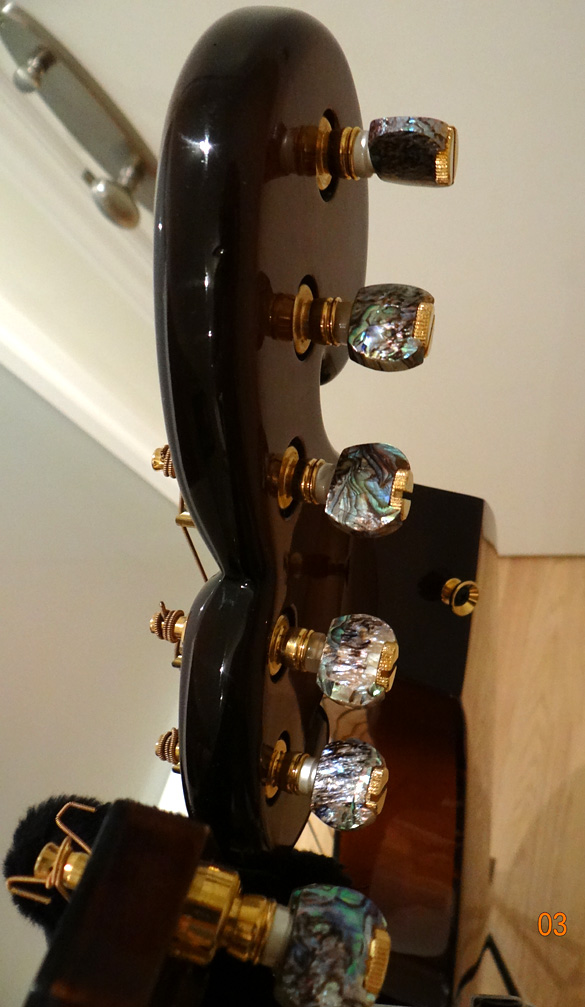
This has fancy banjo tuners (check out those knobs!), as does one side of the main headstock, as the two heads touch where the low E tuner would go.

Dave says he’s been able to deal with the banjo tuners (as most of us can), which Lance only used on this first instrument.

Note the five sub-basses and their position at the bridge, as well as the fact that the bridge is split on this first instrument (this would become a pet peeve with Lance; a harp guitar simply must have a split bridge!). With my only familiarity being with Lance’s later harp guitar I had in my possession, I was interested in seeing the string spacing of his earlier instruments.
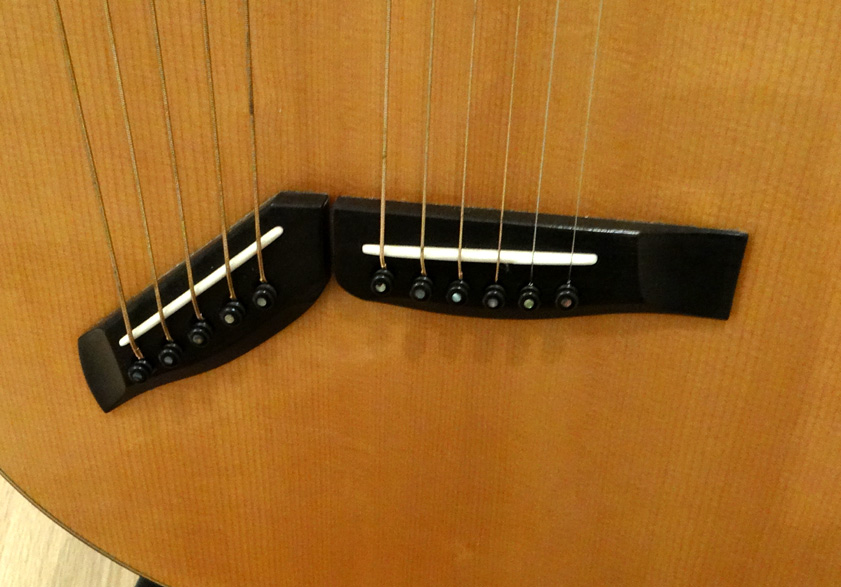
I was surprised to see that HG#1 has a similarly wide gap between string banks. Despite Lance’s familiarity with Dyers (if partial contempt) and his insistence on splitting the bridge, he seems to have gone deliberately overboard on separating the neck strings from the subs, something most of us would find counter-intuitive, if not somewhat illogical from a player’s perspective. Perhaps it had something to do with tonal pursuits?
But again, as I mentioned about the other in my Harp Guitar Music listing, I wonder if Lance was also already thinking of something that might appeal to his “favorite fingerstyle guitarist.” Remember in his post that he mentions going to a Hedges concert, where he mentioned his harp guitar (which he “told him [Hedges] was in production”). There is no hint that any details were discussed (I think we can rest assured that Lance would have mentioned it), so Hedges almost certainly did not suggest it – but perhaps Lance came away from watching him do his sub-bass melody version of harp guitar and thought that this was the way to go for players.
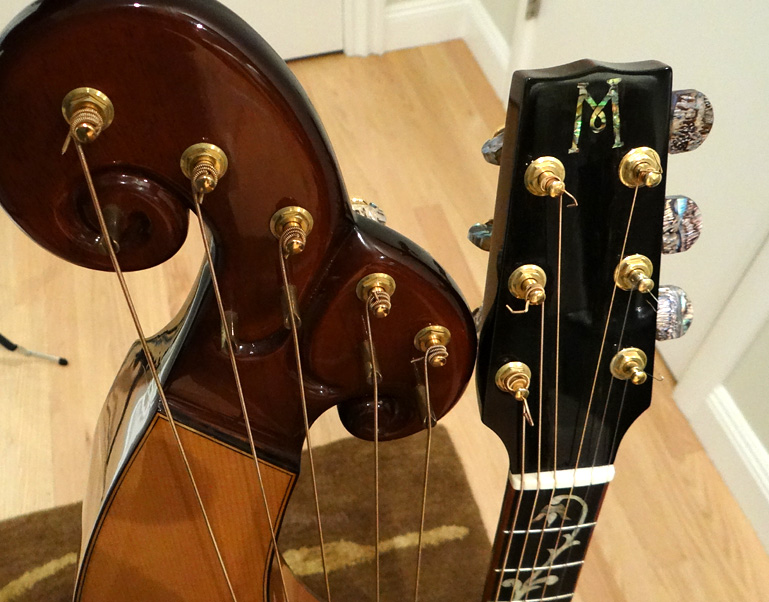
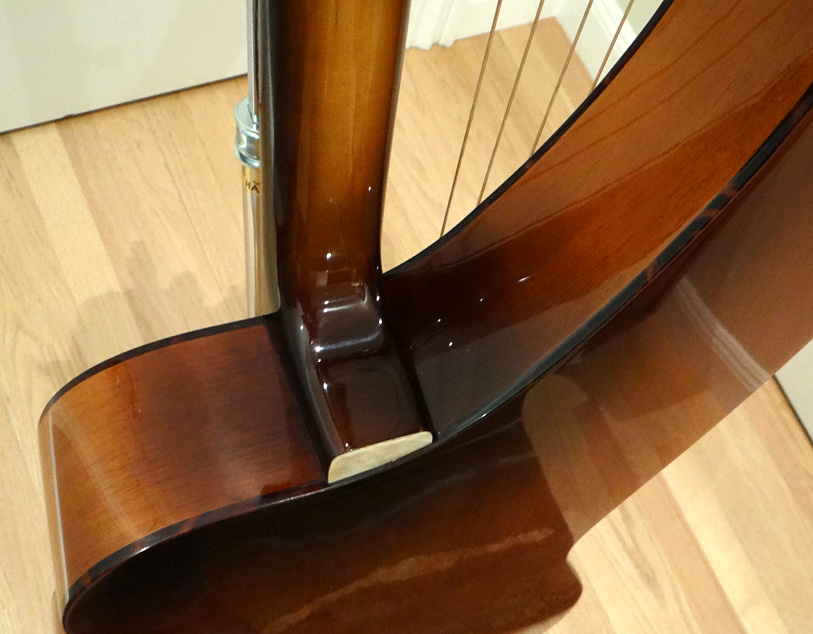
It would be interesting to know when Lance began building this first harp guitar (which some refer to as his “prototype”). For now, we know that it was finished before the Healdsburg Guitar Festival in mid-August, 1997. Again, Lance’s post describes him mentioning the build to Hedges at one concert, then going to a second concert where Hedges demoed the now-completed instrument prior to his soundcheck. That concert must have occurred sometime before Healdsburg, because what I didn’t know before was that Hedges played it again at Healdsburg, immediately after which it sold. This strikes me as very curious, since, as Lance described in his post, Hedges had previously turned down the offer at a concert just before he went out on tour, and that this was the tour he was killed on the way home from. So was Healdsburg a part of that tour? Two McCollum owners (Jost and Hartman) mentioned Hedges stopping by at Healdsburg and playing.
Update 12/18/13: And here, finally, is a photo of that occasion:

Michael Hedges, with McCollum harp guitar no. 1, August, 1997
Something seems off; perhaps it was not at a Hedges concert (Lance referred to it as a “show” with soundcheck and intermission), but at Healdsburg where a one-time Hedges try-out of the McCollum HG#1 took place? Regardless of the specifics (which would still be nice to resolve), we can safely say that David Borbas remains the sole owner of not only the original “prototype” McCollum harp guitar, but the only one that Michael Hedges ever touched.
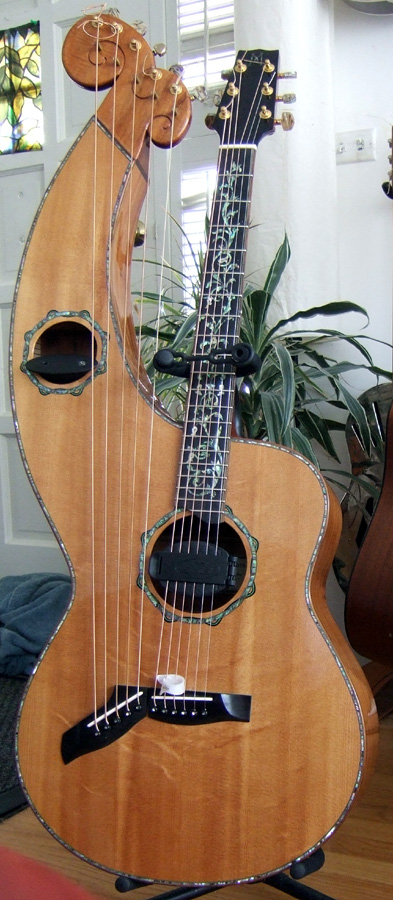
The Hedges/McCollum harp guitar story became a bit more confusing when I was informed by Dr. David Hartman that he owned “the last harp guitar that Michael Hedges ordered but died before he could take possession.” This was “per McCollum before he died.”
Well, that would fit Lance’s posted story that Hedges planned to order one when he returned from tour if HG#1 sold (which, in fact, it had, immediately after Hedges walked away from his impromptu Healdsburg demo). But sadly, he never got a chance to order one, nor did Lance begin building an HG#2 intended for him. When Dr. Hartman sent me this photo of the label, it clearly states “Custom made for Steve Jost” (this one has a serial number of 88, which I assume means that Lance had built 40 other guitars between HG#1 and HG#2…which seems a lot).
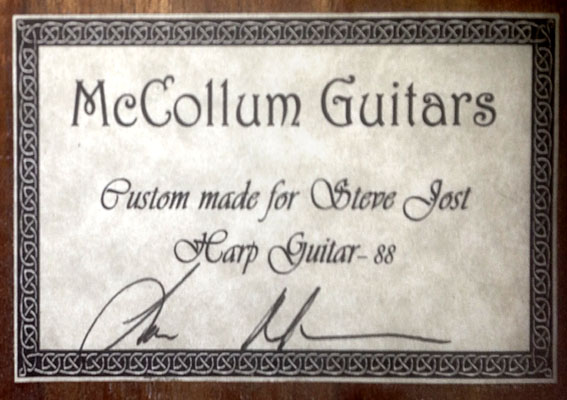
Steve recently added more clarity, telling me: “Lance originally built a prototype harp guitar for the 1997 Healdsburg Guitar Festival. Michael Hedges stopped by and played it (I have a picture). A doctor in San Francisco bought it (GM: he’s referring to Dave Hartman, who bought it in Dec 2007 via Steve’s eBay listing). Michael wanted to have a custom harp guitar built but was concerned that it would change the direction of his current music. In the end, his passing ended that (potential) project. I commissioned Lance in January 1998 to build the second harp guitar (which) was all custom to my specs. He built less than 5 (harp guitars) in his total guitar build of around 300 before his untimely passing (I have 4 other McCollum guitars). I sold the harp guitar to Dave Hartman per my wife’s insistence since I had booked an expensive fly fishing trip to Chile. I was going to have Lance build another, but his passing ended that project.” (Steve Jost)
Steve’s HG#2 (per his specs) also has 5 sub-basses and the same split bridge, but the two banks are significantly closer together – in fact, they seem close to Dyer spacing. Steve must have expensive tastes, as Lance certainly upped the ante on the abalone decoration, along with the bear claw (Sitka?) top and koa back and sides. Note that Lance did another solid carved bass headstock, but copied the Dyer “cloud” more closely this time. He also managed to move the arm a bit out so that he could use all geared tuners. He still had the “M,” rather than his whole name, in the headstock.
Second owner Dave says that it “sounds like a piano.” From all that I’ve seen, this looks like the McCollum to hang on to (in fact, I’m sure I was one of the top underbidders on eBay, hoping for some prime Harp Guitar Music stock. I’m still kicking myself, as this would clearly have been money in the bank…).
Referring back to Lance’s 2000 post, Steve Jost would likely be the first of the “two new McCollum harp guitar owners” he mentioned. The other, whom he names, was Steve Rundell. On his ReverbNation listing, we can see a glimpse of his instrument, which looks very much like #2.
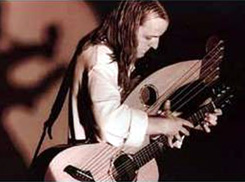
Unfortunately, on his old CDBaby album listing, there was a cryptic reference that Steve “left us rather unexpectedly.” If anyone knows more, please let us know. For now, we know that his (HG#3) was built after HG#2 and before Lance’s post in Oct 2000.
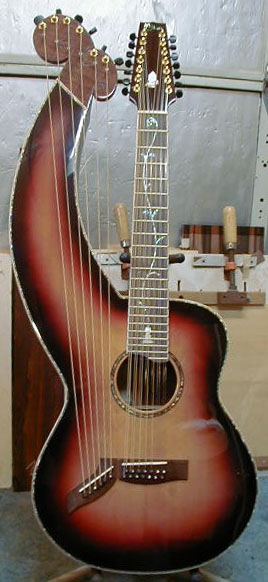
There are two McCollum harp guitars left, and for the moment I’m going to guess that HG#4 is this one. For no other real reason except that it still has a Dyer-shaped bass head. Note that the headstock logo now says “McCollum.” I’ve had this on the site awhile; some have mentioned a 12-string neck, but it’s actually a 14-string…or more accurately, a 7-course version of the 12-string guitar. Six subs make it 20-strings total (and a 13-course instrument for sticklers like myself). This must sound outrageous! I don’t know who commissioned this one, so someone please help us find out (with the usual pics and specs, etc). Note yet another different vine inlay, and that the subs are once again a bit away from the neck strings.

HG#5, then, might have been Lance’s last true harp guitar. It is inscribed under the top “10/18/01” and is serial # H-178. As far as this one’s provenance, we’re missing the original owner (if anyone knows, please let us know!). It was eventually sold through Uncle Kit’s Pickin’ Parlor (Kit does not have records on the original owner) to Brian Mikiten (“I purchased it in 2009 and learned a few Michael Hedges tunes on it before realizing that I needed to focus more on mandolin and guitar.”), who traded it in 2011 to the current owner, Randall Sprinkle.
This is the one I mentioned last week that Kathy Wingert plans to “re-model” in order to add a 6th sub-bass while changing (what one might call “improving”) the spacing. It has walnut back and sides, somewhat more sedate and classy trim, a new bass head design, and a unique sound port on the corner of the arm. The subs are again quite separated and a bit more clustered, while also further away from the neck strings.
UPDATE: Kathy’s conversion is complete! This is how HG#5 looks today (Randall still owns it, but is trying to sell):
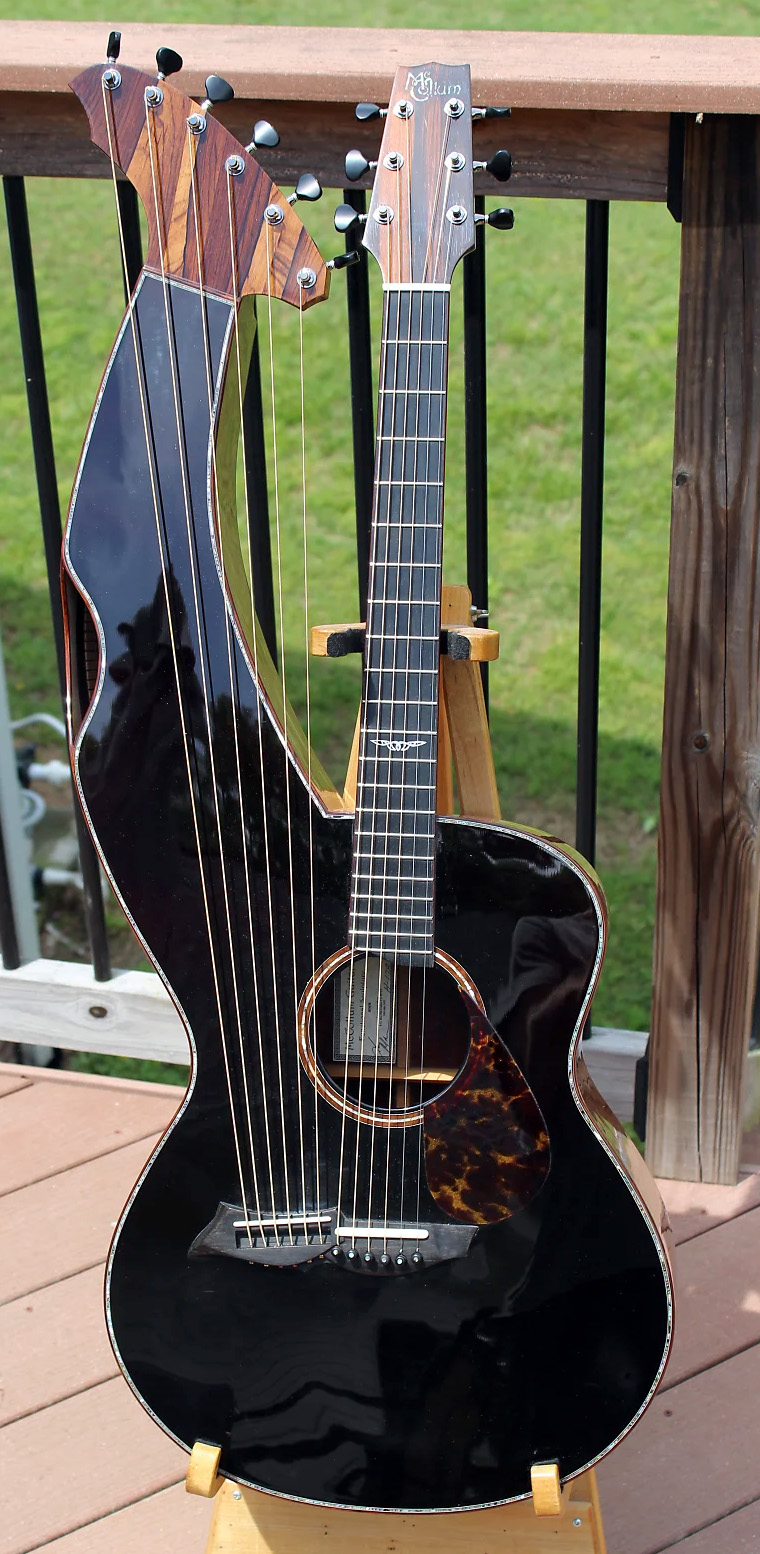
Knowing so much more now just how unique and irreplaceable these five harp guitars are, I am frankly stunned that in two years this instrument has not sold (if Lance were alive and had just built this, I imagine its price would probably be almost double). But it’s not my decision. Again, if this story inspires you, and you have a bit of extra cash (“Is there a doctor in the house?!” comes to mind, looking at some of the owner demographic…), this is last call to acquire McCollum HG#5 in original configuration. Its many unique features (c’mon, that sound port!) can be seen on my Harp Guitar Music listing.
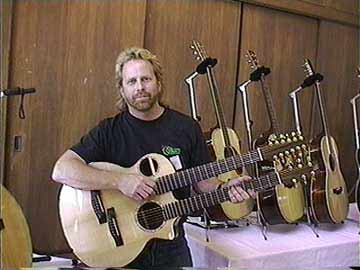
Are there more McCollum harp guitars out there? I almost hate to close the book on this…it’d be nice to think that there’s an “undiscovered” instrument out there. And it’s hard to believe that Lance built five in as many years, then none in his final eight years. He did build at least two double-necks (12 & 6), like the one he’s holding here at the 1998 Acoustic Guitar Festival in San Rafael, CA.
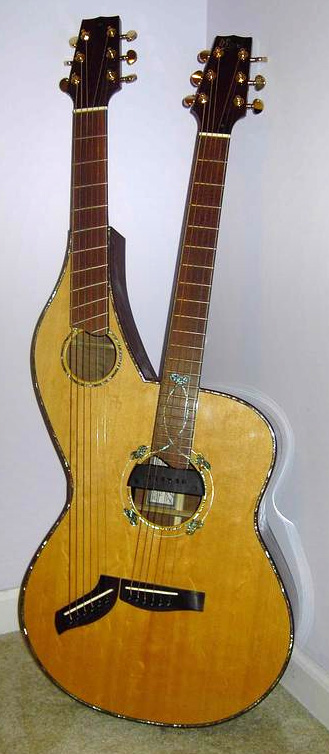
And there is this interesting “fretted harp guitar” he built for Anthony Sandi, which seems to be part harp guitar, part double-neck!
To re-cap, our Work-in-process McCollum Harp Guitar Archive consists of:
HG#1 (ser.# 47, c.1997): The “prototype” he showed Hedges at 1997 Healdsburg – purchased and still owned by Dr. David Borbas of San Francisco. (Mahogany, 5+6, vine inlay, Dyer-ish headstock)
HG#2 (ser.# 88, 1998): Custom ordered in January 1998 by Steve Jost. Sold on eBay in December 2007 to Dr. David Hartman. (Koa, 5+6, fancier vine inlay, more Dyer-like headstock)
HG#3 (ser.# ?, c.1999-2000): Built for Steve Rundell before Oct 2000. (5+6, like HG#2 w/o vine)
HG#4 (ser.# ?): Built for ?, Date? (6+7×2, sunburst, vine inlay)
HG#5 (ser.# H-178, 2001): Original owner unknown, sold through Uncle Kit’s Pickin’ Parlor to Brian Mikiten in 2009, then to Randall Sprinkle, listed at Harp Guitar Music in 2011, currently with Kathy Wingert for re-configure.
Before I close, a quick postscript regarding Michael Hedges’ Dyer. I’m sure all interested players and builders remember that Hedges didn’t play a 5-bass Dyer, but a six-bass with the last hole plugged – as noted in my article and blog. This actually results in a “custom” Dyer string spacing for the five sub-bass notes for “Because It’s There” and other tunes. I also read on that old Google Group thread that someone saw him play all his tunes in concert on his Gibson one time (the Dyer being unavailable?). It would be interesting to know how he strung that, let alone how he could play it like a Dyer (I assume he had pickups that got the thing to sound great). Because that versatility makes me think of another eyewitness report (on the Nomad site?) about how in concert Hedges would play a 6-bass Dyer tune, then, while doing something on regular 6-string, his guitar tech would remove one of the sub-basses so that Hedges would not become confused when he next played “B.I.T” or some similar 5-bass tune. Apparently, this string went back on and back off every night! Was this his second reported Dyer? Or the “original” Style 4? I ask because while researching for this article, I stumbled upon an exhibit held just last year that included Hedges’ harp guitar (did any of you see it?).
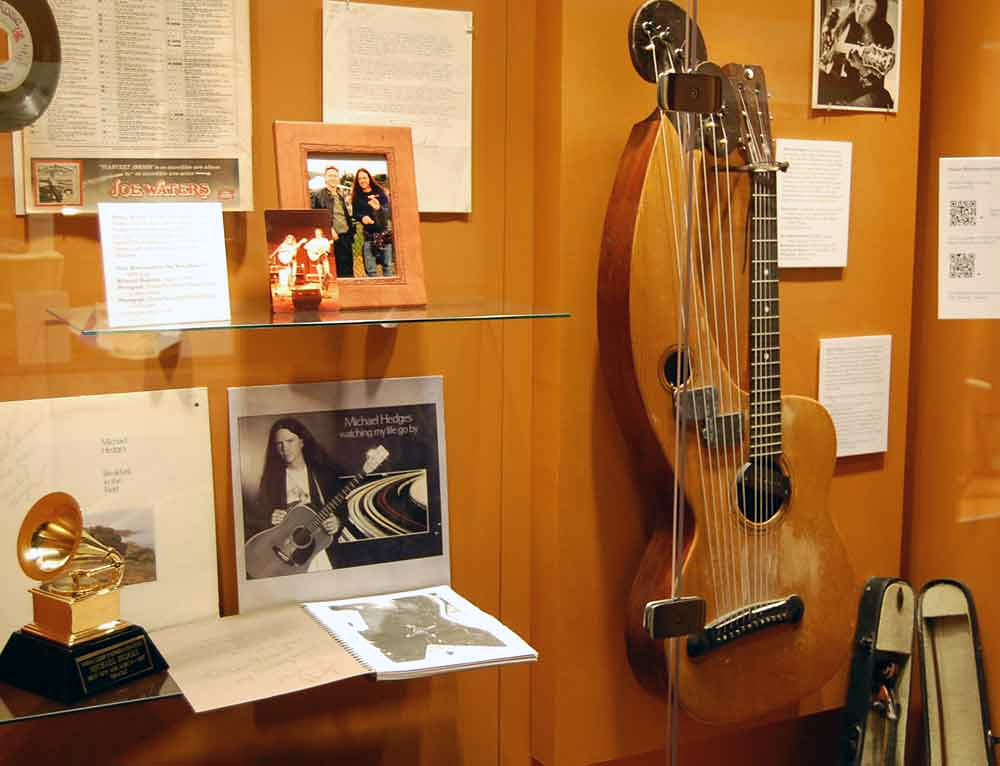
You can clearly see that it is his old plugged-hole Style 4, but now it has the 6th bass installed! Aren’t there major Hedges geeks out there that know about this stuff? Where is his guitar tech or friends that know these details, and why do I (who am a fan, but not a fanatic) seem to be the only one asking?
Again, this is relatively recent and fresh history. Why not actually finish the research and archive and tribute to both Michael Hedges and Lance McCollum? Hey, I consider myself very marginally in the loop of either of their careers, and I just wrote 3500 words (and having finished, am now going to raise a glass and toast the memory of these gentlemen).
Your turn…
Thanks to the following for photos and/or information: David Borbas, David Hartman, Steve Jost, Brian Mikiten, Randall Sprinkle, Kathy Wingert

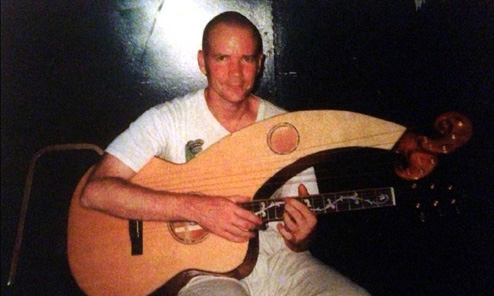
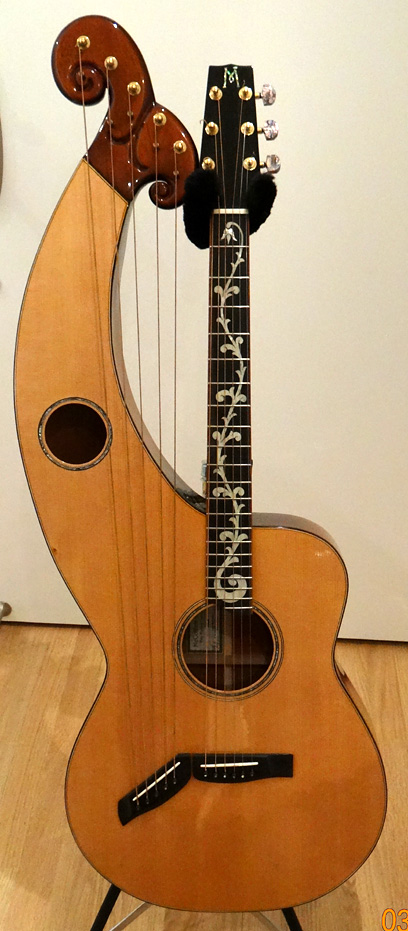
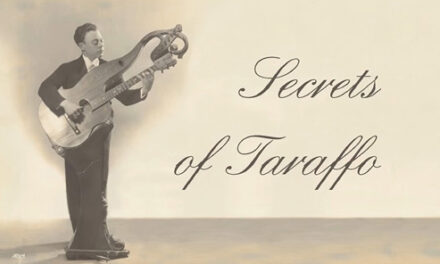
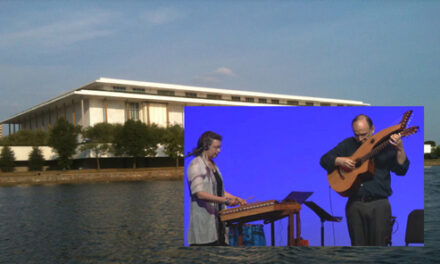
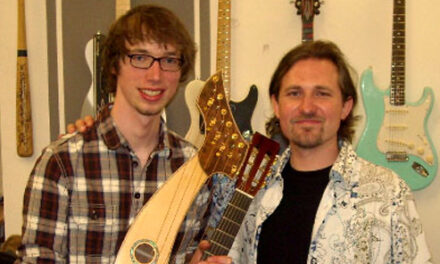
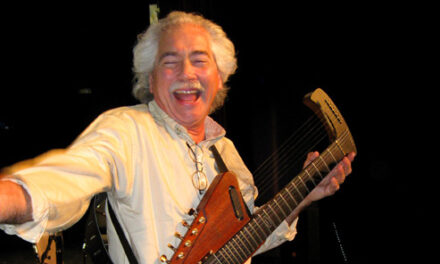
Fascinating thread. I’m an early Lance customer, having commissioned #25 in 1996 (a Grand Auditorium in Engelmann/Brazilian). Now well broken in, it is still the best-sounding steel string guitar I have ever played — or heard, for that matter. I traded design work for part of the price of the guitar and wound up designing his logo and his first brochure. In 2004 he called me and said he was raising prices but would honor the old spec sheet for original customers. This resulted in my commissioning a baritone, guitar #245, in Italian spruce/Brazilian. Its tone can only be described as profound. I designed a 12th-fret inlay for it, and Lance had Larry Robinson put it in. It’s perfect, and perfectly lovely. Lance always used a 15th-fret join on his baritones as far as I know.
I played one of Lance’s harp guitars, probably #2 (?), when it was owned by a collector in the Oakland hills, who was offering it for sale, I think. I forget his name, though it’s likely printed in your excellent account above. (If you’re reading this, I’m the guy who bought your all-koa Goodall parlor guitar that day, which is still living a good life with me.)
So: I wonder if anyone (Dawn, or Greg Mauel?) has compiled a database of the roughly 300 instruments Lance built. It would be a shame to let his memory die. He had the touch, and when it comes to guitars there’s nothing else in my experience that comes close.
–Scott Fitzgerrell
I am the original owner of the HG#5 McCollum harp guitar. I bought it directly from Lance. He wanted to buy his kids a ski boat, so he gave me a good deal on it.
David, Trust me on this…..the vine inlay on the neck was only $1500 during the build. I am sure it did not increase more than 5 fold when I sold it. As a side note, Lance was not happy with me when I sold it. I never did figure that one out. The Abolone tuner buttons were Lance’s idea. I took them off and replaced them with ebony buttons but because there were pictures floating around (including Acoustic Guitar Magazine) I replaced them when I sold it to you. This guitar was not a build for MH. Lance thought from the MH meeting that he would be building a HG for MH. When MH passed I commissioned the now Hartman HG build. Nothing was started for MH…if it was it certainly would not have been KOA and Bearclaw Sitka. This forum is bringing back a lot of fond memories….Steve
Couple of minor additions to the guitar that may or may not have been started for Michael Hedges and completed for Steve Jost. The guitar was originally fitted with all abalone tuners, but while they were beautiful, they were spectacularly bad tuners. The material could not hold up turning the strings and wore through, causing them to have no grip. The gold tuners were included when I bought the guitar from Steve, and I replaced the abalones regretfully.
I also recall asking Lance about the cost that Steve was selling the guitar for on eBay. Lance told me that the price at the time bought the guitar, would only have paid for the neck inlay work…nothing else….
The guitar does sound very piano like with the koa back and sides giving it a tremendous ring and sparkle. The sound hole in the armature gives the guitar a stereo effect to the player.
Finally, I’m in Chicago; I wish I was, per Steve Jost, in San Francisco…
My association with Lance McCollum starts back in 2006 or 2007 I ordered a
baritone guitar from him after talking with Paul Huemiller at Dream Guitars. I had been playing a Santa Cruz baritone guitar and I really like it but it was a guitar with a 12 fret neck joint and I wanted a baritone with a cutaway.
In my experience the world of baritone guitars is a little like harp guitars, there is a lot of difference in opinion about the standard tuning. The Santa Cruz was designed to be tuned down to D or C, most other baritones are meant to be tuned to B or A.
Paul said there would be no issues and Lance was the best baritone builder
around. I placed my order through Paul, and at some point I called Lance to
discuss the guitar with him. He was none too happy to learn that I wanted him to build a baritone with a cutaway that would be tuned to D.
He built the guitar but he ignored the cutaway request, when the guitar was
delivered to me I realized that the neck joined the body at the 15 th fret so a cutaway was not really needed. Paul refunded the cost of the cutaway so
everything was fine as far as I was concerned.
In 2009 I attended the Swannanoa gathering for the first time, it was a mind
blowing experience. I signed up for a class called Finger picking the Beatles
taught by some guy named Stephen Bennett.
The second day of the class Stephen pulled out his old harp guitar to play some songs for us. I had heard of a harp guitar but never seen or heard one. As they say the rest is history.
That same year I had a class with a gentleman named Joe Giacoio and in another class his wife Carla Ulbrich. We shared several meals together and it turned out that Joe was into this Harp Guitar thing also. Seems to be a trend, or a virus!
Joe also had a wonderful Ryan Mission Grand Concert guitar but he didn’t like
it. I played it for several hours and really loved the guitar. Joe also
mentioned that he was looking for a baritone guitar. Joe and Carla stopped by my house in North Carolina on their way back to New Jersey, and we traded guitars. My McCollum baritone for his Ryan.
Fast forward a couple of years, I can’t get the harp guitar thing out of my mind so when the Holloway guitars become available I get one from the first shipment. It was an OK guitar, it got me started and I decided that I wanted to try to learn a new instrument.
Very soon after I got the Holloway, I saw an ad on the acoustic guitar forum for a fellow that wanted to trade a McCollum harp guitar for a nice arch top guitar. I knew enough about Lance from owning the baritone that the harp guitar would be a great instrument. I had an Andersen arch top that I didn’t play very much, so I sent the owner Brian an email and we started negotiating a trade.
When he first sent the pictures, I was a little confused to see it only had 5
bass strings. I didn’t really know enough to notice the way the bass strings
were arranged.
We agreed to ship our guitars to each other with either one of us having the
right to terminate the trade. When I got the McCollum in my hands I knew that it was a very special guitar but I also figured out pretty quickly that the bass strings would be an issue in my pursuit to play just like Stephen Bennett. Of course there were other issues with that, but that’s another story!
Soon after that I contacted Gregg to see about consigning the McHarp with him so I could raise some money to buy a better harp guitar than the Holloway.
So now the McCollum is shipped off and I stumble across a harp guitar that was built by Tony Karol. I knew his name, because I had seen SB play a baritone built by Tony. I contacted Stephen to get his opinion on this harp guitar, and then I contacted Tony.
Tony told me the guitar was for sale but since it was the first one that he had built he wanted to keep it for a couple of months to display at the Toronto guitar show. That was fine with me because I needed to raise some funds.
So now I’m back at the Swannanoa Gathering again and I’m playing the Ryan
guitar. I met another gentleman that is looking to buy a Ryan. It’s looking
like that is my path to raising the money to buy the Karol Harp guitar so I make a deal and the Ryan goes away.
In the meantime I also sell the Holloway. When I take delivery of the Karol I
start playing it a lot. I have been fully infected by the virus.
Now we’re up to 2012 and I tell my wife that I’m going to the Harp Guitar
Gathering in Texas, she looks at me like I have gone off the deep end. I recruit my youngest son (Caleb) to come along for some driving training. Road Trip!
Caleb and I are welcomed into this cult, I mean group, with open arms. Our theory is the group needs new blood. Somewhere along the way from NC to Texas I thought to tell Caleb that this group was led by a self appointed “pope”. He’s very amused by this.
At the harp guitar gathering I have a chance to meet Kathy Wingert and talk with her about the possibility of converting the McCollum to a “standard” harp guitar. I am surprised when she says that it could be done and that she was willing to do it. Her caveat was that she would do it on her time, when she could work it in.
That was good enough for me, so here we are. After reading all the research
Gregg has done I am a little reluctant to go through with it but ultimately I
think it will be a more playable instrument for me, my son or any potential
buyer. And in the end it’s better for the guitar to be played than for folks to look at it and wonder why the bass strings are spaced so differently.
I found the picture that Lance gave me of Michael playing the “first McCollum Harp Guitar” as pictured in this article. I will scan and send in the next few days. The HG built for me that I sold to David is in fact a Bear Claw Sitka Spruce top. We did get a bit carried away on the build and it ended up with a final price of $10,500. That was the first of 6 guitars that Lance built for me over a 10 year timespan. I have guitar #298 (KOA top, Back Sides & Headstock – Braz Rosewood binding) this was one of the last guitars Lance built. He was a great guy. His wife Dawn is also a wonderful woman. I attended NAMM shows as Lance’s Guest, drank wine with him at his house in Colfax and talked non stop about guitars. I truly miss him….. Steve
What a fun and fascinating read. Thanks for keeping track of and sharing this important HG history. I will probably only build a total of 7 HG’s in my lifetime because I only have 7 cases to fill (HG #3 begins tomorrow). I just finished building a 7 string guitar (not a harp guitar) having been influenced by our Russian guest at the last gathering. I think that the harp guitar world is growing but still small enough that the documentation of builders and their instruments can be easily lost or confused. Again, thank you for this site and all that you do for the HG groupie in me.
Michael